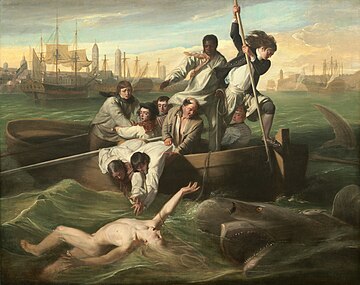
Back واتسون والقرش Arabic Watson and the Shark Breton Watson and the Shark Danish Watson und der Hai German واتسون و کوسه Persian Watson et le Requin French Ուոթսոնը և շնաձուկը Armenian Watson e lo squalo Italian Вотсон и ајкулата Macedonian Watson i rekin Polish

Watson and the Shark is an oil painting by the Anglo-American painter John Singleton Copley, depicting the rescue of the English boy Brook Watson from a shark attack in Havana, Cuba. Copley, then living in London, painted three versions, which are all now in the United States. The 1778 version is in the National Gallery of Art, Washington, D.C. A second, full-size 1778 replica is now in the Museum of Fine Arts, Boston, and a third, smaller, 1782 version with a more vertical composition is in the Detroit Institute of Arts.
The paintings are based on an attack that took place in Havana harbour in 1749. Brook Watson, then a 14-year-old cabin boy on the Royal Consort,[1] lost his right leg below the knee in the attack, and was not rescued until the third attempt, which is the subject of the painting.[2] Watson, having had a military career and become a successful merchant, commissioned the painting from Copley a quarter of century after the event. Watson went on to be chairman of Lloyd's of London, a Member of Parliament, and Lord Mayor of London.
- ^ Brayman, James (1852). "Escape from a shark". Thrilling adventures by land and sea. Being remarkable historical facts, gathered from authentic sources. G. H. Derby and co., Buffalo, N.Y. p. 89. Retrieved 19 August 2019.
While lying in the harbor at Havana, it was very hot on board the Royal Consort, about four o'clock in the afternoon of the 14th July.
- ^ "Copley's Watson and the Shark", Meg Floryan, Smarthistory, accessed December 20, 2012.